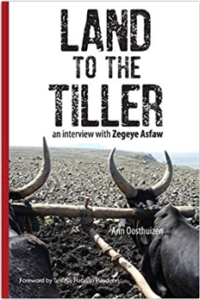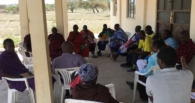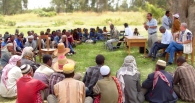Robin Palmer reviews Land to the Tiller
Robin Palmer
8 July 2020
/
- 0 Comments
In this article Robin Palmer reviews Land to the Tiller: an interview with Zegeye Asfaw by Ann Oosthuizen. This is an interview with Zegeye Asfaw from 2012, telling the story of his life, of the struggle for land reform in Ethiopia, and of the personal cost of that struggle for himself and others.
This is one of the most unusual books about land reform I’ve ever read. And I have read a good few!
In large part this is due to its structure. It is only 136 pages long. The bulk of it is based on interviews given in the Lime Tree Café in Addis Ababa over two weeks in September 2012 by the Ethiopian land activist Zegeye Asfaw to the South Africa-born writer Ann Oosthuizen. It has been extremely well edited.
The first 6 chapters cover Zegeye’s family background (well off landowners in Oromia), his working within land ministries under first Emperor Haile Selassie, then the Derg, later the Transitional Government, his imprisonment for ten years by the Derg and his subsequent release, and his 1995 founding of the NGO Hundee (root of a tree). Chapter 7 comprises memories of prison, a conversation with fellow land activist and prisoner Ababiya Abajobir, and the final chapter contains the memories of ‘three high achievers of the following generation who have been influenced by Zegeye.’ (p.115).
So what we get is the inside story of a deeply committed land activist working to promote ‘land to the tiller’ in a rapidly changing political and economic landscape, lobbying government from the outside, working within very different governments, enduring ten years in prison, and later founding a local NGO with a very strong commitment to women’s land rights.
Zegeye writes about the tenants having
‘to pay one quarter or one third of what they produced annually to the landlord. Also tenants’ wives had to provide services and go to work in the household of the landlord, and even the husband and the children were expected to give free labour. They could be evicted at any time. They were literally slaves.’ (pp.21-2).
In prison Zegeye was told that head of state Mengistu Haile Mariam
‘gave strict instructions that they should not touch my body, just to make my statement, and that is how I escaped the Derg’s torture. All my friends, the other Oromo, were tortured… The torturers were trained in the GDR and the Soviet Union.’ (pp.62-3).
He was only allowed to see his family again after six years in jail. Later he criticised Mengistu to his face about implementation of the villagization programme, citing experiences in Tanzania and Mongolia. (p.73). Later still he told USAID that ‘Farmers don’t give invoices (as USAID had wanted) in Ethiopia’ and won his case. (p.89). By 2012 ‘his’ NGO Hundee had ‘between 70,000 and 80,000 clients. Over 70% are women – women farmers, businesswomen.’ (p.91).
I really enjoyed reading Land to the Tiller. I suspect that readers unfamiliar with Ethiopian history and politics might have benefitted from something a little more substantial than two pages of significant dates and four pages of glossary and acronyms at the end of the book. Come to think of it, it might also have been useful to have inserted the words ‘in Ethiopia’ in the title!
Finally, Ethiopia has been a serious victim of the global land grab yet there is just a single, rather optimistic, mention of this:
‘But now the government has given the authority [to take land for a public purpose] to the administrators. They can take over the land and give it to an investor. This is the biggest crisis in land reform. There are land-grabbing Indian, Pakistani, Saudi governments, who want to grow food for their own food security, or there is the international flower industry – land reform is being affected by all these threats. But in the majority of cases July2020_RPal the land is still in the hands of the peasants.’ (p.112).
That was recorded in the Addis café back in 2012 and (like the rest of the book) has not been updated. I would be very interested to learn whether Zegeye Asfaw still believes this to be the case eight years later.
Catherine Dom has also reviewed ‘Land to the Tiller’ which can found on Mokoro’s website here.



